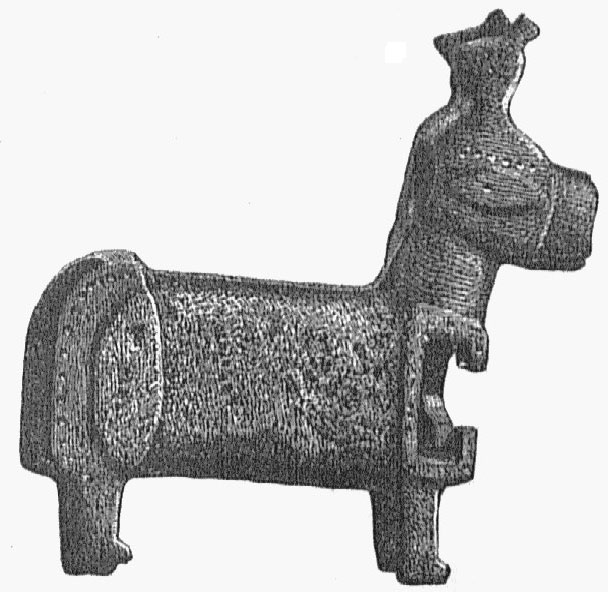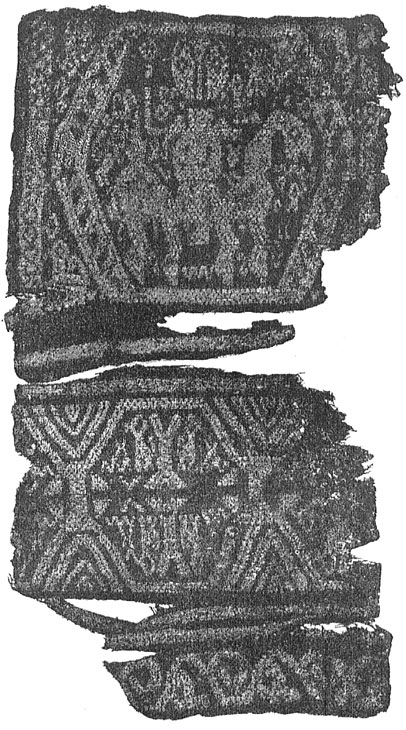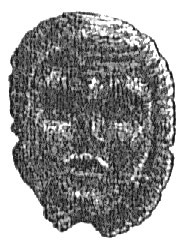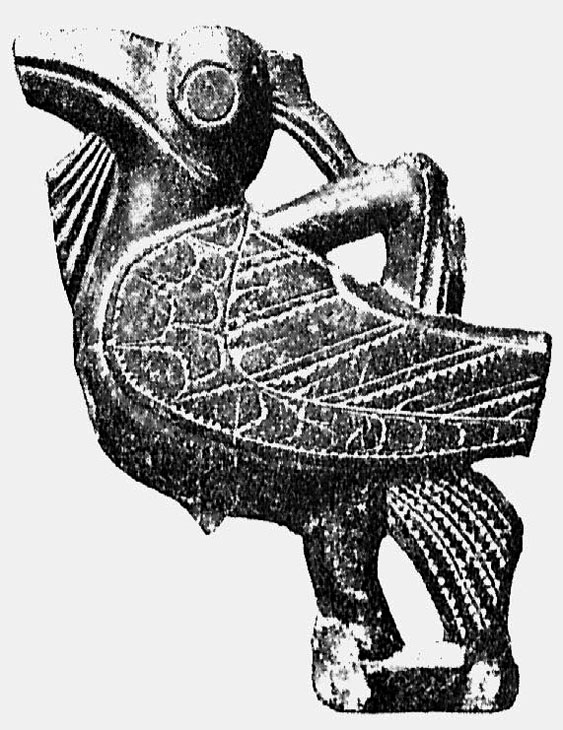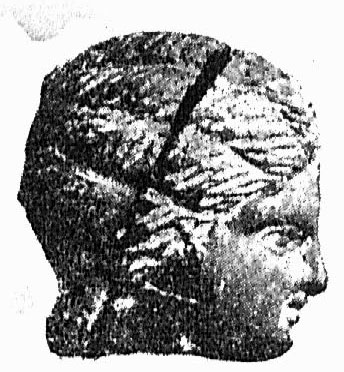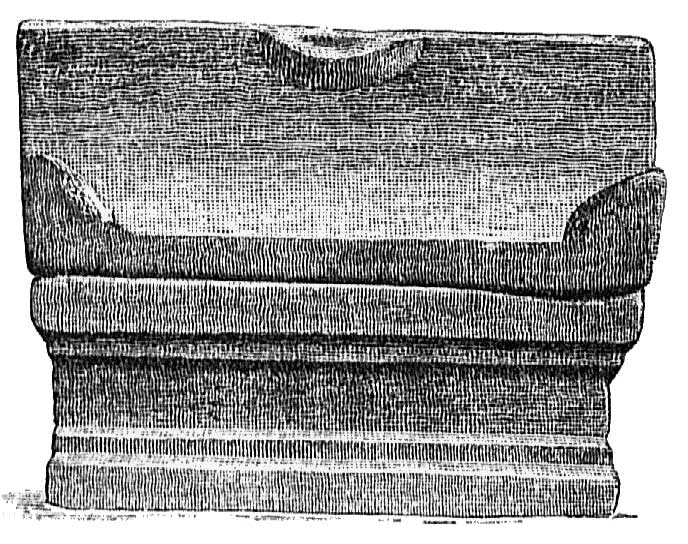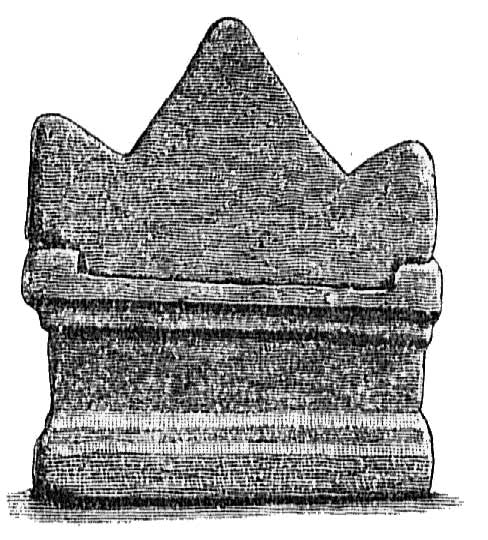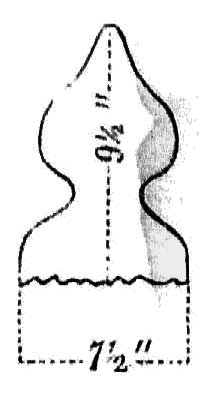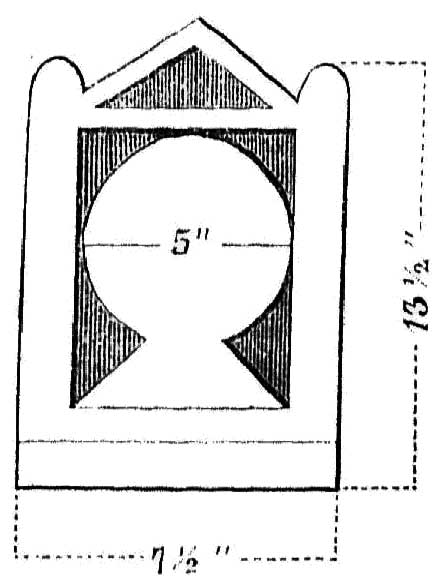|
Year of 1891 ...
I. EXCAVATIONS IN TAURIC PROVINCE
When doing these works, special attention was paid to both further investigation of the city-site of Chersonesos, within the city walls, and searching for ancient cemeteries of this city.
In order to investigate the first area, employee of the Archaeological Commission K.K.Koistsyushko-Valyuzhinich who was entrusted with the above-mentioned works, have made excavations:
- in the area around the new church;
- on the north shore of the sea from the beginning of the basilica discovered in 1853 by c<ount> A.S.Uvarov to the big cistern half-ruined by the sea;
- on the same shore, in the situation where traces of a square of ancient Chersonesos had been discovered in 1890;
- near the wall that separates the square from the monastery hotel;
- close to the new north monastery wall, towards to the big church with mosaic floor;
- near the new east monastery wall, to the right from the main street;
- in the south-east extremity of the city, near the military funk-hole;
- in the same area of the city, on the east shore;
- close to coastal battery in the north area of the city;
- at the north-west extremity <of the city>, at the west wall, on the steep sea shore.
- The area around new church was laid out, so the sites of ancient churches and buildins had been discovered and charted yet in 1861, when it had been made an order to built church in this place to commemorate the baptism of h<oly> gr<and> pr<ince> Vladimir. As the new church should be finished in November 1891, the Archaeological Commission ordered to make investigation, down to bedrock, of all those parts of the square around the church where it was possible to be made without doing damage to works on construction of the church. Unfortunately, it was possible to make such excavations only 'by heaping up', that is to say without removing earth and stone and without uncovering lowermost layers of the city-site. It should be pity of that, the more so, the quantity and the outstanding importance of the finds from the upper layers allows one to suggest that this square occupied a great position in the city centre in Byzantine, as well as in Greek and Roman periods. It is impossible not to underline the sorrowful fact that the vast area of the city-site comprising one third of the whole Chersonesos is built, without insistent need, with different monastery constructions.
No excavations were made in the south, behind the remains of the church with mosaic floor, as this area was a mound
that appeared after the square was laid out in 1861. It is possible to organize further investigation of this area in
its east side, when the monastery will start destroying temporary sheds in front of the church and removing stone piled
up in huge number behind uryadnik's house. This way, the finds were made in the west area,
which had been dug over in 1890 and, mainly, in the north area, which was investigated down to bedrock in the current
year. East side has been dug as a narrow strip, from the pavement of the church to the temporary museum, and, in the
south side, remains of two churches were investigated, renovated, and would be conserved as is.
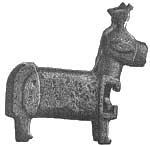
|
| Fig. 1 |
Marble stele with excellently preserved Greek inscription of 56 lines, that contains oath of faithfulness to
Chersonesos, Karkinitis, and Beauty Port (it has been published and explained by V.V.Latyshev in Materialy po arkheologii
Rossii ['Materials for the archaeology of Russia'], vol. 9, p<ages> 1-13); marble pedestal of statue dedicated,
as the part of inscription that remained on it, states, to Athena the Savior (s<ee> ibidem, p<age> 24);
fragment of marble slab with Greek inscriptions, of which 10 considerably damaged lines remained (ibidem, p<age>
18); 8 fragments of slabs with traces of Greek inscriptions (ibidem, p. 31-34); 6 splinters of marble cornice with
Greek one-line inscription and beautiful deep carving (ibidem, p. 34-35); fragment of marble cornice, greatly
damaged by fire, with fragment of Byzantine inscription (ibidem, p. 36); 3 fragments of marble slab with rough
image of human figure (headless) driving to the altar table, seemingly, a ram; marble slab with image of lion coming
to amphora, on its edge; slab of stone with image of jumping panther; slab of stone with image of some two animals
with highly raised tails, looking to opposite directions; fragment of big marble statue with visible bosom, the
hand that holds cloths,
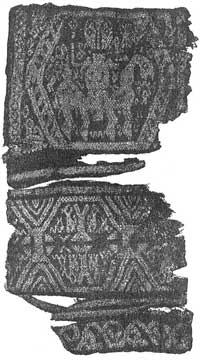
|
| Fig. 2 |
and the other <hand> let down; fragment of marble cornice of Ionic style (splinter of similar cornice was uncovered in 1888); fragment of capital of sandstone, with egg-and-darts; 4 stone limestone slabs with images of big crosses; marble quadrangular elongated baptismal font with hole to drain water and image of cross at every narrow side, like on capitals; big marble circular column; fragment of marble capital with relief wreath; slab of limestone, covered with decorations as double, intersecting circles; marble cornice with 2 crosses on sides and rosette in the middle, which is connected with crosses; iron church candlestick (3'2'' high), consisted of double circle (8' in diameter), quadrangular one-inch rod, and three feet; half of bronze reliquary cross with image of Savior wearing long clothes; bronze cup with decorated with carving lid (box for weights?); bronze weight in the form of sphere with truncated poles; circular weight of black stone, bronze folding key, bronze padlock in the form of monster
(s<ee> fig<ure> 1)
whose ears are replaced with two sitting birds; pieces of compact silk fabric, one of which has well-preserved image of a horseman in Oriental style
(s<ee> fig<ure> 2)
and 2 gold coins of Basilius I and Constantine VIII are the most important finds. 17 ancient cisterns of quadrangular and circular shape and different size were excavated on the square as well. A circular cistern (2 ½' in diameter and 47'' deep), which was probably used as catch pit for liquid sewage because it reaches the sea water level (similar cistern was discovered in 1888, in the eastern area of the city-site, near coroplastic workshop), is especially interesting among them.
- Excavations on the north shore of the sea started near the big cistern, in which some saw remains of ancient stairway,
others remains of a tower. Reconnaissance of the long waterside discovered remains of buildings, walls and cisterns,
most part of them was carried away by the sea long time ago,
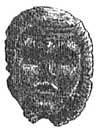
|
| Fig. 3 |
and proved that the north shore of Chersonesos was greatly destroyed. Two carved in rock cisterns are visible in water in clear weather; these certainly could not be located behind fortification wall in the time when the city existed. Among the finds uncovered there, the following deserve attention: big, damaged marble head of male statue, of barbarian style; marble, greatly damaged figure of Silen; bronze idol with braided hear as on stone baby; 2 bottoms of clay glazed pottery with images of eagle on one and riding warrior on the other; glass flat oval bead with wide channel and image of human face on both sides
(s<ee> fig<ure> no. 3)
; big lead sinker, cone-shaped, to which top iron hook was probably fastened, and breaken off something image of monster bird of black stone
(s<ee> fig<ure> no. 4)
.

|
| Fig. 4 |
When making reconnaissances near the basilica discovered in 1853 by c<ount> A. S. Uvarov, 11 sazh<enes>
fare from the outer wall of its chancel, small church was discovered, with three tombs, in which, apart from multitude
of bones, there were 2 bronze coins of Romanus I; bronze circular mirror; bronze earring and bonze button.
2 bronze wall-spikes and big iron, covered with plate bronze cross, decorated with rosettes in dotted circles on
its points and with dotted line and string-shaped border on every side and with medallion with half-length image of
Savior in the middle were found in the small church. Second small church is uncovered 11 sazh<enes> to
S<outh> from the big cistern, that was washed out by the sea; it also contained three tombs, in which, besides bones, there
were: in long narrow tomb with one skeleton, bronze cross with eye-hole and inscription on both sides; three bronze
buttons and bronze coin of Romanus I, and in two others 13 glass bracelets, bronze finger-ring, 4 bronze earrings, upper part
of icon lamp chain, part of fine bronze chain, 9 bronze fine buttons, broken gold spiral, and part of brocade.
- On the same north shore of the sea, but fare westwards, where traces of an ancient square had been discovered in 1890, the excavations continued along the line of southern wall of the street, discovered in the same year; a part of, destroyed by the sea, apse of another small church was discovered 5 sazh<enes> from the first small church (s<ee> 1890 report) to W<est>; big marble column laid in the upper layer of the ground. Lower than the street, down to the very bedrock, there was a continuous layer of remains of broken pottery, both coarse and slipped, terracotta wares and stamped amphora handles. Besides that, big, roughly hewn, sandstone gravestone, on smooth surface of which Greek two-line inscription was carved, that dates to the fourth c<entury> BC (see Mater<ialy> po arkheol<ogii>
Rossii ['Materials for the archaeology of Russia'], vol. 9, p<age> 26);
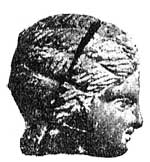
|
| Fig. 5 |
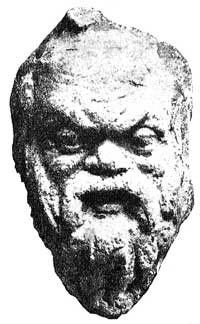
|
| Fig. 6 |
small fragment of marble slab with a part of badly preserved Greek inscription of 4 lines (ibidem, p<age> 33); terracotta head of a man with sharp features and half-open mouth; greatly damaged part of male figure of soft stone; terracotta head of <high> artistic quality
(s<ee> fig<ure> No. 5)
; terracotta hand of Silen, of beautiful style
(s<ee> fig<ure> No. 6)
; terracotta statuette which was evidently made in mold listed in Mater<ialy> po arkheol<ogii>
Rossii ('Materials for the archaeology of Russia'), vol. 7, pl<ate> III, 4; terracotta figure of Nice (headless); two marble hands, one of medium size, another small; 28 fragments of various terracotta statuettes; 3 fragments of terracotta ornamentation; few pieces of wall plaster of red and gray colour; marble female head, greatly damaged; clay black slip vase; 2 shards of clay black slip cup with holes like in censers; 48 whole and 28 broken clay lamps; 20 bottoms of black slip pottery with letters scratched on them; up to 350 amphora handles with names of astynomoi, monograms of manufacturers, and various emblems; 8 clay amphora necks and 2 fragments of roof tiles with Greek inscriptions were found there.
If one added the finds, mentioned in 1890 report, to this list, one will easily be convinced that all the places of the city-site of Chersonesos, where excavations were arranged, together do not supply such a number of ancient pottery and terracotta wares shards as this insignificant area of narrow coastal strip.
It is impossible not to pay attention to another fact: no lower tier of buildings, which are discovered everywhere in Chersonesos during excavations, is found under two small churches and upper city street, down to the very bedrock, so there are all reasons to consider that this area was a square in the ancient city. Further investigations will probably find final answer to this question.
- A part of collapsed small church with two tombs is uncovered little over 8 sazhenes from the wall that separates the square from the monastery hotel; no smallest trace remain of the apse. The outermost narrow tomb all projects outside, and the one annexed to it goes deep to 4'6'' and is covered with solid, beautiful vaulting. The first tomb contained only bones, the second, apart from the bones, 6 glass bracelets and small clay vessel under bright green glaze.
- Small but interesting in regard to its architecture church, constructed of sawn stone, is uncovered 5 sazh<enes> from the new north monastery wall, to the left from the gate, in one direction with the big church with mosaic floor. Its floor of flagstones was lower than the surface of earth, so it was need to go down by staircase of three steps. Maximum height of the wall preserved is 5'6''. Amidst hewn stone, there were 8 slabs of vaulting with Greek letters preserved in some places, which were written with brown paint on the wall plaster and were not readable. Granite column (2'4'' high) of sacrificial table remained in chancel in situ; in Mr Berthier Delagarde's point of view, it had been located in a pagan temple earlier.
2 marble, carved capitals and plain marble base were uncovered in the small church, laying on the floor and leaned to pillars, and were used probably for seating as marble columns could not be there, these were replaced with stone pillars. In the tomb, in its south-west corner, there were only bones. Fragment of a marble slab with six letters of very large Latin inscription (s<ee> Mater<ialy> po arkheol<ogii> Rossii ['Materials for the archaeology of Russia'], vol. 9, p<age> 35) was uncovered on the floor of the small church.
Similar to the majority of churches uncovered in Chersonesos, this small church bears the traces of later reconstruction: the door in the south wall is blocked with stone, the staircase is removed, the vault to the right from the main entrance is blocked and plastered, and an outer tomb was constructed of slabs in the corner.
- There was a greatly damaged church, with five tombs and without any fragment of marble members, located 15 sazh<enes> from the new east monastery wall, behind the temporary museum, to the right from the main street. Apart from the bones, 2 fragments of glass mosaic, copper earring, 9 bronze buttons, glass bead, piece of silk fabric, scrap of textile with 2 bronze small closed bells sewn to it, part of bronze icon lamp chain, and 6 glass bracelets were found in the tombs.
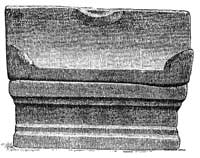 |
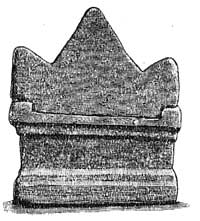 |
| Fig. 7a |
Fig. 7b |
Burial church, one of the most interesting because of both its architecture and finds, is uncovered in the same area of the city, to the right from the main street, e<astwards>. All the remains of marble parts were broken into smallest pieces because of the influence of fire. 2 burnt, cracked marble bases remained at places where 4 columns stood, in the southern side, though only foundations remained in the northern <side>. Only bones remained in two tombs. Fragment of a marble column with 7 holes to fasten cross and roughly carved fine Byzantine inscription, unreadable, 2 fragments of thin marble column, and fragment of marble floor mosaic were uncovered on the floor of the small church. 6 clay amporae of rough quality were taken from a small cistern <located> in front of the apse, between its wall and the wall of the building closest to it. Inside the apse, on the same level as the floor which was poured with concrete, there was quadrangular hole, faced with slabs, and inside of it, in dry ground that will the pit, coffin of pure white marble with sliding lid was placed
(s<ee> fig. No 7a and No. 7b with image of its longitudinal and transverse sides)
. This coffin was probably used as a casket for relics and contained nothing but a dark brown spot on its bottom. Under the small church, there was big, strong vault, which was divided into narrow passageway and 3 tombs by slabs, where, apart from multitude of bones, 18 glass bracelets including two pieces of blue glass with gilding
(s<ee> fig<ure> No. 8)
, 10 bronze buttons, cypress cross and cypress toothcomb were found.
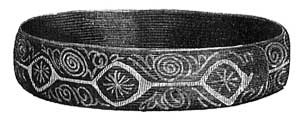
|
| Fig. 8 |
- Big church, greatly damaged and touched by unskilled and hurried excavation, with remains of a floor of marble slabs and 19 tombs, was uncovered in the south-east extremity of the city, near the military funk-hole. In Mr Berthier Delagarde's opinion, this was one of the churches discovered by Kruse, who made excavations on admiral Greyg's instructions. In this church, the form of chancel is interesting as it is rear in Chersonesos and similar to <that of> the church to the right from the basilica discovered by c<ount> Uvarov.
The tombs are 6'-7' or 1'7''- 4'3'' long and 1'3''- 5' d<eep>. 8 of them are carved in bedrock and located one near another; these may be related to some earlier church, though the others, external ones (some of them are faced and covered with marble stones), were undoubtedly constructed simultaneously to rough reconstruction of the church, <which consisted of> building rubble walls instead of colonnades and blocking doors of two tombs. The church was built at place of ancient structure, which is crossed by the church. Only one of bases of the colonnade remained in situ. Marble slab (4'3'' х 2'7'' х 4') with image of cross in its centre and leaves on its corners; incomplete marble slab (5'8<''> long and 3'' thick), also decorated with cross; 2 fragments of marble slab with a part of cross in circles (these slabs were, according to the cuts from below, in the corners, and the same cuts in bases, put between columns to separate naive from chapels); marble slab (1'11'' high and 1¼' wide) with beautiful vine-shaped ornamentation; fragment of marble slab with few letters of a Greek inscription; piece of a marble cornice with 7 Greek letters in one line; 2 marble, carved capitals; marble base, multitude of fragments of marble slabs, columns and cornices, and doorstep of marble; fragment of marble pigeon (parts of marble pigeon were found in 1890 when excavating the church on a hill); gold coin of Honorius; bronze coins of Arcadius, Leo I, Basilius I, Romanus I, Leo VI, Romanus II, Constantine X, Nicephorus Phocas were found inside the church. Apart from the bones, bronze coins of Basilius, Romanus, Nicephorus Phocas, fragment of a marble slab with rough image of a bird, 7 bronze buttons, pair of bronze earrings, 11 glass bracelets, clay glazed vessel and more than 200 pieces of glass mosaic, multicoloured and with gilding were found in the tombs.
- A small church with two tombs was uncovered in the same area of the city, on the steep east shore of the sea, 6'8'' far from the defensive walls. Iconostasis in this small church evidently was of wood, as parts of rotted wood and wide bronze band with inverted sides were found in the chancel. This band was riveted in two places and broken into 4 pieces, which were 9'5'' long (the small church was 9'8'' wide). Truncated cones, with the base out, 20 pieces in total, were fastened to the band at one side, every 5'. This band could be placed on top of the iconostasis, and the cones could support bronze candlesticks: 17 such artifacts were found here, shaped like spindle but with flat base. 3 bronze icon lamp stands laid in the same place. Besides that, broken clay glazed cup, two bronze coins of Basilius I and Romanus I, top section of icon lamp chain, 2 fragments of a flat glass vessel, two glass bracelets, 8 bronze buttons, broken bronze finger-ring with glass <mount>, big iron key, 3 fragments of marble slabs with crosses, decomposed textile and big lead seal with 2 holes and image of St. Eugene and emperor, both on horseback, similar to images on coins of Comnenes of Trebizond were uncovered in the small church.
- A small church, interesting because of both its architecture and the finds, and built above vaulted tombs, was uncovered 28 sazh<enes> far from the coastal battery, to the N<orth> of the big church with mosaic floor. This church architecture is the same as that of the church located on the opposite side of the big basilica with mosaic floor. Here, marble columns are similarly replaced with 4 stone pillars; there are 5 niches of square and semicircular form inside the walls. Besides the main entrance with staircase of 3 steps, there had been two side entrances, one of which was blocked with stone: this fact indicated that the church was reconstructed in the later period. Trenches made in these annexes (their walls are erected on the walls of the ancient building), down to bedrock, are 7'6'' deep. Apart from clay shards under glazing, coarsely-made bronze statuette of Zeus the Thunderer
(s<ee> fig<ure> No. 9)
is found in this place.

|
| Fig. 9 |
Vaulted tomb is unique due to its size and occupies the whole area under the church; the vaults between stone pillars are of different heights: near the entrance 3'10''; in the middle of the tomb, where pits in bedrock are located, 5'6''; in the south-east corner 3'; in the north-east 4'5''. Maximum length of this burial vault is 35'2''; maximum width is 20', and height is 5'6''. Big gold coin of John Tzimisches, gold signet-ring which stone fell out, 3 silver plain bracelets, a dice, fragment of marble circle with a part of in-divided cross and two letters, 2 fragments of clay glazed pottery with image of human head on one of them, fine clay ball, piece of read paint, handle of brown paste that fell into pieces, and two bronze coins of Basilius I and Constantine VIII were found in the small church. The burial vault contained 20 bronze buttons, 2 bronze finger-rings, 2 bronze bracelets with beads threaded on them, 12 glass bracelets, cypress comb, part of cypress cross, cord of 8 strands of wool, bronze cross with eye, 3 bronze earrings and bronze coins of Romanus I, Romanus II and Constantine X.
- An excavation was made at the north-west extremity, at the city wall, on the steep sea shore, with the aim to investigate north defensive wall, most part of which is destroyed by the sea. A big stone at the west wall was taken as the starting point of the excavations; it appeared to be a projection of the bedrock. A catacomb has been revealed here, that was turned into a tomb in the Byzantine period; its side niches were blocked with brick; multitude of bones laid on the floor in disorder. The descent to the catacomb was covered with vaulting, above which it was possible to go into the door (3'10'') leading to the big cross-shaped building, with flagstone floor and 7 inner tombs, in which, apart from the bones, 10 glass bracelets, bronze bracelet of rough quality and pair of bronze earrings were found.
A door lead from the south extremity of this cross-shaped building to the small church with brick floor and two tombs. A pit, that was 3' <deep>, shaped like elongated decahedron, and faced with marble slab, was uncovered in the chancel floor. Relics storage was probably located there. The second small church with mosaic, greatly damaged, floor was uncovered 5-7 sazh<enes> E<astwards> from the cross-shaped building. Technique and drawing of the mosaic has many in common with the image of mosaic in the basilica discovered by c<ount> Uvarov, so it was one of the most early church, but because it was discovered in the most remote area of the city-site and there was no physical possibility to preserve it, Mr Kostsyushko-Valyuzhinich was in a hurry to remove the part of the floor that was better preserved. One could explain the important, striking difference in directions of chancels of these two small churches, separated by few sazh<enes> only, only as a result of the fact that, in relatively later period, when the church with cross-shaped annexe was being built, the more ancient church did not existed long since. The present discovery of this church was an absolute accident, as the soil in this area is a smooth surface, without any smallest trace of remains of any building, and especially churches, that exist in it.
Only altar rail of stone slabs (2'7'' high) and marble doorstep remained in situ in this interesting building. The chancel floor is made of stone slabs. 4 tombs, where only bones were uncovered, are located in front of the small church. On the north, it is annexed by big tomb and vault with marble doorstep and excellent brick vaulting of a special brickwork, which was not found before and consisted in bricks laid so that they composed a dome, and the masonry finished with one brick in the middle. Apart from bones, only one bone fine-moulded fastener was found in the burial vault. Sandstone capital, of high artistic quality, and two fragments of marble column were uncovered near the small church.
Further investigation of the area near which some ancient tombs had been uncovered in 1890 resulted in the discovery of two more tombs that were carved in bedrock and plastered. One of these <tombs> appeared to be plundered and contained only circular, plain gold badge and broken clay lamp; bronze Chersonesian coin and terracotta lamp with relief image of eagle were uncovered in the other.
At the same place, three catacombs are uncovered; one of these was plundered completely, another contained scattered human bones and small blue glass vessel, and the third had no usual niches nor shelves and contained three skeletons, laying on the floor, with greatly deformed skulls, and, amidst them, fragments of coarse clay pots, pair of silver earrings with 14-hedral pendants, earring of the similar form, but of medium size, and two silver rings which were evidently used to hang thick earrings.
There were two more catacombs uncovered: first on a path leading from the monastery to vegetable gardens, another was mentioned above, when describing to churches annexed to each other; it was a tomb in the Byzantine period <and was located> near the steep sea shore, close to the west wall. The first one was plundered and contained splinter of a marble slab with 2 letters of a Greek inscription and rough image of lower part of female's cloth; in the second, on the floor and in niches, there was an accumulation of numerous bones, amidst which 5 bronze coins of Theodosius the Great and 3 clay juglets were uncovered.
The discovery of the catacomb at the west city wall, under the cross-shaped annexe to the small church, induced Mr Kostsyushko-Valyuzhinich to hypothesize that some graves might be located near the south wall also. His hypothesis came quite true: his excavations on the slope behind the south city wall really discovered large cemetery, starting to the left from the new gate, at the powder-magazine and watch-house of the fortress artillery, and finishing with the gully where temporary barracks is located.
68 burial structures are uncovered along about 106 sq<uare> sazh<enes>, excavated in this area; plan, dimensions, and content of these were described in details in the 1st Appendix to the given report. Multitude of scattered human bones, coins, and various ancient artifacts, uncovered in the mound that covered these graves, proves that once this place housed many other ancient tombs that are completely destroyed now, but it is impossible to determine the number of such tombs, even approximately,
because these were gradually destroyed when making next burials and the new ones were arranged at their place.
68 burial places mentioned above supply evidences of the existence of 2 ways of funeral in Chersonesos: a) burying the corpses, and b) incinerating them, <the latter structures> consist of 8 tombs constructed of hewn stone slabs (grav<es> 1-3, 15, 38, 54, 55, 61), in 3 tombs faced with roof tiles (grav<es> 5, 53, 62), one grave cut in bedrock (grav<e> 12), 43 tombs faced with fine stone (grav<es> 4, 7-11, 13, 14, 16-19, 21, 22, 24-34, 36-37, 39-45, 52, 58, 59, 63-68; including 4 child's: 9, 24, 26 and 33), 12 clay separate urns (grav<es> 6, 20, 35, 46-51, 56, 57, 60) and one catacomb (grav<e> 23).
Graves with slabs facing the walls were constructed on the bedrock, with one exception (grav<e> 54), which was made in the mound, and oriented with the length from N<orth> to S<outh>, 1-3 arch<ines> deep from the surface. These are divided into 2 types: a) cist, that were covered with triple tier of slabs from above, placed as corbels, and b) cists, that were covered with one slab only. Only one grave with slabs facing the walls (55th) contained skeletons of the dead, another (38th) contained not only lead urn and clay urn with incinerated human bones and buried skeletons as well, six other graves (1, 2, 3, 15, 54, 61) contained clay and lead urns only, with ashes of incinerated dead.
In the graves with slabs facing the walls of the 1st type, the urns stood very close to each other, in grave of the 2nd type these are deeply in stone boxes.
Tiled graves contained skeletons of the dead, were arranged above the bedrock, at depth down to 4 arch<ines> from the surface of the mound, and were faced with roof tiles on each side and from above (the prevailing size of the latter is 17' х 12'' х 1'), of the same form as roof tiles of the Byzantine city of Chersonesos; one artifact (in t<omb> 5th) kept a stamp with the Greek name and image of eagle on fish (like on coins of Sinope, Olbia, Istria, etc.).
Carved in bedrock tomb (12th) was covered by a slab and contained 2 clay urns with fired bones laying on its bottom.
The tombs faced with fine stones were located in the cemetery mound on different depth, in most cases between lumps of stone, or were arranged in bedrock. Their directions are very different and depend closely on bedrock strata. The skeletons laid on ground and were faced with fine stones of different size, but were not covered by roof tiles or slabs. Only one plundered tomb (68) was covered with three pieces of a marble slab, with incomplete Graeco-Latin inscription, containing correspondence between the Chersonessians and Roman governor of Moesia Inferior regarding violation of the rules of tax collection from brothels. This inscriptions is published and explained by V.V.Latyshev in the 9th volume of Materialy po arkheologii Rossii (Materials for the archaeology of Russia), p<ages> 39-45.
Clay urns with incinerated bones that were uncovered separately, had been dug in ground and gravel of the mound, without any facing, in one line with graves with slabs facing the walls nos. 1-3, 4-5 arch<ine> deep from the surface.
The catacomb was roughly carved in bedrock without niches and shelves, went up as a hemisphere (s<ee> App<endix> 1, gr<ave> 23), and contained partly skeletons buried in wooden coffins and with heads oriented to the S<outh>-W<est>, and partly incinerated bones placed in urns and stone coffin with Greek inscription (publ<ished> by V.V.Latyshev in the same Materialy, p<age> 30-31).
One can divide the urns (both buried separately and placed in tombs), according to the outward appearance, into 10 different types (s<ee> Ist Appendix, grav<es> 15, 23, 38, 46, 49, 51, 54, 56, 57, 61), with insignificant variations; all lead urns are greatly damaged. The most popular type is the urn uncovered in the catacomb (no. 23, V); there is one specimen only of each urn which were placed in tombs 46th, 49th, 56th and 61st, and two-handled urn with inscription in tomb 15th. Most part of urns was covered with clay plugs, one was covered with clay cup (in t<omb> 56th); one lead (in t<omb> 38th) with lead lid with screws; corks of 29 urns were placed on top only, and were not plastered, and only one three-handled urn (t<omb> 38th) was uncovered covered closely and stuck with lime. There are Greek inscriptions inscribed on some urns (t<ombs> 2, 15, 23, 38).
The antiquities uncovered in this cemetery are listed in the above-mentioned Appendix to the given Report, in details, for each grave separately, and consist of the following artifacts:
- glass bottles (gr<aves> 2, 3, 13-15, 18, 23-25, 29, 32, 33, 35, 38, 46, 47, 51, 54-57, 61, 65, 66), cups (t<ombs> 17, 25, 29), and other vessels (gr<aves> 3, 57), pendants (gr<aves> 24, 38), and twisted stick (gr<ave> 65);
- clay jugs (gr<aves> 3, 13, 14, 27, 30, 32, 37, 52, 53, 62, 63, 66), vases (gr<aves> 7, 36, 55, 61), including one of red clay and shaped like young man's head (gr<ave> 55), cups (gr<aves> 2, 23, 30, 32-34, 39, 61, 62, 67), plates (gr<aves> 30, 32, 44, 53, 61, 62), and oth<er> vessels (<graves> 3, 23, 31, 39, 44, 45, 52), lamps (gr<aves> 2, 3, 14, 23, 24, 27, 32, 37, 39, 41, 47, 62, 66), of which many are decorated with relief images of human figures, animals, flowers, etc., and few statuettes (gr<aves> 3, 42, 55.);
- bone: spoons (gr<aves> 2, 6), boxes (gr<aves> 3, 23, 63), awls (gr<aves> 3. 24, 38, 52, 54, 61), chiselled handles (gr<aves> 3, 23), rings (gr<aves> 23, 24), pendants (gr<aves> 26, 33, 54, 55, 60, 61), combs (gr<ave> 17) and a dice (gr<ave> 24);
- wooden: rods (gr<ave> 23) and box (gr<ave> 23);
- gold: leaves (gr<aves> 2-4, 6, 12, 14, 15, 21, 23, 28, 35, 38, 46-48, 51, 54, 55, 57, 60, 61, 67), earrings (gr<aves> 3, 15, 23, 26, 29, 38, 40, 43, 55-57, 58), embossed plates (gr<aves> 3, 4, 23, 61, 62), finger-rings (gr<aves> 23, 38), beads (gr<aves> 3, 38, 52) and pendants (gr<aves> 1, 3, 23, 38, 40);
- silver: earrings (gr<aves> 1, 34, 43, 50), bracelets (gr<ave> 43), finger-ring (gr<ave> 31), and enameled cross (gr<ave> 11);
- bronze: brooches (gr<aves> 2, 3, 9, 17, 23, 27, 34, 38, 50, 52, 54, 59, 61, 62), fasteners (gr<ave> 3), buckles (gr<aves> 2, 3, 10, 15, 19, 23, 20, 31, 38, 40, 42, 54, 59, 66), earrings (gr<aves> 3, 10, 14, 56), bracelets (gr<aves> 1, 3, 23, 30, 32, 37, 38, 52, 61-67), mirrors (gr<aves> 1, 3, 5, 38, 66), spoons (gr<aves> 3, 16, 24, 54), needles (gr<aves> 3, 15, 27, 31, 35, 38, 50, 62), rings, badges, pendants (gr<aves> 1, 10, 16, 23, 27, 34, 38, 42, 54, 59), fine open bells (gr<aves> 10, 23, 27, 38), keys (gr<aves> 2, 17), neck ring (gr<ave> 14), finger-ring (gr<ave> 50), stud (gr<ave> 24), cross (gr<ave> 11), statuette (gr<ave> 1), and lid of a vessel (gr<ave> 24);
- iron: knives (gr<aves> 15, 24, 31, 38), strigils (gr<aves> 2, 15, 38, 48), seal-rings and finger-rings (gr<aves> 15, 38);
- stone: hones (gr<aves> 3, 15, 24, 27, 38), plaques (gr<ave> 47), various images (gr<aves> 1, 8, 23, 37, 38), wide-channel beads of rock crystal (gr<aves> 3, 38, 55, 62, 63), carnelian (gr<aves> 3, 38, 40, 50, 52, 53, 55, 61, 63), jet-stone (gr<aves> 38, 55, 63), green and blue stones (gr<aves> 21, 45);
- beads: glass (gr<aves> 2, 3, 9-11, 14, 16, 22-24, 26, 31, 34, 35, 38, 40-42, 44, 47, 52, 58-63, 65, 67), amber (gr<aves> 1, 3, 22, 23, 26, 38, 40, 45, 52, 53, 55, 63), coral (gr<aves> 23, 40), glass shard (gr<aves> 38, 55) and glass paste (gr<aves> 2, 3, 8, 19, 23, 26-29, 33, 53-55, 61, 64);
- leather: straps (gr<ave> 23);
- woolen fabric (gr<ave> 23);
- pierced animal tooth (gr<ave> 1);
- sheep knucklebone (gr<ave> 40);
- egg (gr<ave> 33);
- shells (gr<aves> 3, 24, 65);
- pink paint (gr<ave> 65);
- coins: silver Roman, framed in gold as medallions (gr<ave> 3), and bronze: Roman as well (gr<aves> 23, 24, 27, 28, 61, 64), Bosphoran (gr<aves> 28, 33), Chersonesian (gr<aves> 7, 15-19, 21, 23, 25, 29-31, 36, 40, 41, 44, 59, 63, 65), Byzantine (gr<ave> 32, 34), Sinopean (gr<aves> 8, 45), and of Amisos (gr<ave> 62) and Philippopolis (gr<ave> 27).
Regarding the position of the antiquities at buried skeletons, Mr Kostsyushko-Valyuzhinich informs as follows. If there was mixed pottery in a tomb, glass bottles usually laid at the skeleton's head, and clay jugs and cups both at legs and at sides of it; uniform pottery was placed differently, at the head, at legs, and at sides of the skeletons, often in all these places simultaneously. Bone boxes were found at the side, gold leaves at the head. If there was one coin in a tomb (mainly Chersonesian one, of the IInd period), it always was at the head, and if there were few, those laid on each side of the skeleton.
Skulls of some skeletons are greatly deformed. Three such skulls were uncovered in the catacomb (no. 23) and one in the tomb faced with big roof tiles with ancient Greek stamps (no. 5).
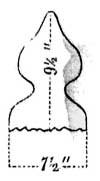
|
| Fig. 10 |

|
| Fig. 11 |
Marble slab with ancient Greek inscription (s<ee> Mater<ialy> po arkheol<ogii> Rossii [Materials for the archaeology of Russia], vol. 9, p<age> 26), fragment of marble slab with a part of Latin inscription of 3 lines (ibidem, p<age> 35), 3 stone child's gravestones of rough quality
(s<ee> att<ached> fig<ure> No. 10)
, fragment of lid of small marble coffin, same as coffin lid from catacomb no. 23, two stone projections, knocked off a certain monument
(s<ee> att<ached> fig<ure> No. 11)
, two fragments of ancient roof tile with stamps, 18 stamped amphora handles, 2 bronze coins, worn and with countermark of Chersonesos, 7 bronze Chersonesian coins, silver coin of Caracalla (?), bronze coins of: Julius Philippus, Claudius and Agrippina, Valentinianus I, Justinian I, Rescuporis V, bronze coins of: Amisos and Tarentum (?), bronze plain circle similar to a coin, head of terracotta figure of a woman, 2 bronze artifacts like modern seals, 3 lead urn lids, and the following clay artifacts: top of two-handled amphora with red-painted letters ?Z, 2 complete two-handled amphora, toy amphora, 3 juglets, saucer, black-slip plate, stemmed vessel, 2 lamps with unclear relief images, two plain lamps and circle with relief head of beardless man were uncovered in gravel and ground of the mound covering the necropolis mentioned above.
Besides that, the Chair of the Archaeological Commission A.A.Bobrinskiy, being transient to Kerch, investigated in Chersonesos two catacombs and a tomb on a slope on the left side of the road leading from Sevastopol to Chersonesian monastery, short of the ancient walls of Chersonesos. Both catacombs and usual type tombs were repeatedly found in this place before. These graves have no external features.
One catacomb, investigated by c<ount> Bobrinskiy, was discovered on the depth of 1.5 m below the ground level. Square entrance hole was carved in bedrock and lead to the underground chamber. This hole was 0.54 metre wide and 0.67 m<etre> high. Two made in bedrock steps lead to it. Slab that was intended to cover this entrance pit appeared to be heaved off, and the catacomb was plundered. The chamber was spacious inside (its length was 3.9 metres, width 3.6 m<etres>, height 1.4 m<etres>) and oriented from N<orth> to S<outh> lengthwise. Inside, it was plastered and divided into three, symmetrically located and carved in rock, sections. One is just opposite to the entrance hole, second to the right, third to the left; each section consists of a shelf, carefully smoothed in rock, where human bones are scattered; under this smooth shelf there is, between it and bedrock, empty space, now heaped up with ground, but originally aimed to bury as well; in the same way, broken and disorderly left bones are discovered in ground under the slab. All the catacomb had been, obviously, plundered in ancient times, because of which it was partly filled with ground. There were, besides fragments of human bones, few more amphora shards. Top of the catacomb was not smoothed. It contained burials with remains of, evidently, no less than 3 human beings.
A bit higher on the same slope, at the depth of 1.4 m below the ground level, there was carved in bedrock, stone rectangular tomb; no its top slab survived, the tomb was overwhelmed with ground. Its length (from N<orth> to S<outh>) exceeds 2 m<etres>; width 0.64 m<etres>, depth ½ m<etres>. This tomb was absolutely empty; even no bone survived in it, only a few amphora shards were found.
At the same place, at the depth of 1 ½ m<etres>, another catacomb was discovered, with the same square entrance hole as in the first one, but of bigger size. In front of the entrance, there was big, heavy, heaved off slab and two crosses roughly cut on limestone, near it; there were no inscriptions on the crosses, both have one of side parts broken off. The entrance hole was densely blocked with big and small stones. On the outside, in front of the hole, there was a small platform with three carved in rock stairs, leading to it from the opposite side.
This catacomb was 2 arch<ines> 13 versh<oks> wide near the entrance, 2 arch<ines> 11 versh<oks> near the rear wall, 3 arch<ines> 8 versh<oks> long, and 2 arch<ines> 17 versh<oks> high. Niches' length: opposite to the entrance 2 arch<ines> 8 versh<oks>, of side ones 2 arch<ines> 12 versh<oks>, depth 1 arch<ine> 6 versh<oks>, height 1 arch<ine> 8 versh<oks>. Projection's height above the foot of niches is 3 versh<oks>, above the foot of catacomb 1 arch<ine>. Inside, in the wall opposite to the entrance and in two side walls, big niches are carved as semicircle, and a small niche is carved in every of big ones. The catacomb appeared to be plundered; it contained bones and two bronze buckles only.
For the detailed report of the excavations made in Chersonesos see Appendix.
From 1891 Report of the Imperial Archaeological Commission signed by the Chair, count A. A. Bobrinskiy. Published in Saint Petersburg in 1893.
|



